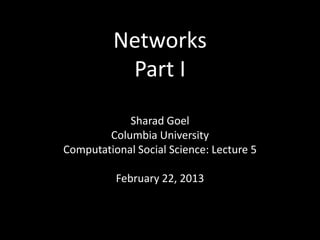
Network Analysis Concepts and Algorithms
- 1. Networks Part I Sharad Goel Columbia University Computational Social Science: Lecture 5 February 22, 2013
- 2. High School Dating Network [ Bearman, Moody, & Stovel, 2004 ] Image by Mark Newman, via Easley & Kleinberg
- 3. Corporate E-mail Communication [ Adamic & Adar, 2004 ] via Easley & Kleinberg
- 4. “Internet map 2004” from Math Insight http://mathinsight.org/image/internet_map_jurvetson_2004
- 5. Networks/Graphs Nodes/vertices people, organizations, webpages, computers Edges represent connections between pairs of nodes
- 9. 2 5 11 1 4 9 6 2
- 10. 1 2 4 6 4 2 1 2 3 7 13
- 11. 3 1 2 5 4 1 2 3 4 5 6 7 7 1 0 1 0 1 0 0 0 6 2 1 0 1 0 1 0 0 3 0 1 0 0 1 0 0 4 1 0 0 0 1 0 0 5 0 1 1 1 0 1 1 6 0 0 0 0 1 0 0 7 0 0 0 0 1 0 0
- 12. 3 1 2 5 4 7 1 {2, 4} 6 2 {1, 3, 5} 3 {2, 5} 4 {1, 5} 5 {2, 3, 4, 6, 7} 6 {5} 7 {5}
- 13. 3 1 2 5 4 (1, 2) 7 (1, 4) 6 (2, 3) (2, 5) (3, 5) (4, 5) (5, 6) (5, 7)
- 14. 2 5 3 1 2 11 1 4 9 5 4 2 6 7 6 1 {2:2, 4:4} 2 {1:2, 3:5, 5:11} 3 {2:5, 5:1} 4 {1:4, 5:9} 5 {2:11, 3:1, 4:9, 6:6, 7:2} 6 {5:6} 7 {5:2}
- 15. 2 5 3 1 2 11 1 4 9 5 4 2 6 (1, 2, 2) 7 (1, 4, 4) 6 (2, 3, 5) (2, 5, 11) (3, 5, 1) (4, 5, 9) (5, 6, 6) (5, 7, 2)
- 16. Adjacency list edge list (weighted) directed network Input Adjacency list Output Edge list
- 17. Adjacency list edge list (weighted) directed network Map input: u {w1, …, wk} foreach wi: output (u, wi) Reduce pass
- 18. Edge list adjacency list (weighted) undirected network Input Edge list Output Adjacency list
- 19. Edge list adjacency list (weighted) undirected network Map input: (u, w) output: (u, w), key := u output: (w, u), key := w Reduce input: u, {w1, …, wk} identity
- 20. 3 1 2 5 4 7 6 Degree of node u # of edges incident on u
- 21. Edge list node degrees undirected network Input Edge list Output Node degrees
- 22. Edge list node degrees undirected network Map input: (u, w) output: (u, w), key := u output: (w, u), key := w Reduce input: u, {w1, …, wk} output: u, k
- 23. Edge list degree distribution undirected network Input Edge list Output Degree distribution
- 24. Edge list degree distribution undirected network Map input: (u, w) output: (u, w), key := u output: (w, u), key := w Reduce input: u, {w1, …, wk} output: u, k
- 25. Edge list degree distribution undirected network Map input: u, k identity, key := k Reduce input: k, {u1, …, um} output: k, m
- 26. 3 1 2 5 4 7 6 Path Sequence of nodes with each consecutive pair connected by an edge
- 27. 3 1 2 5 4 7 6 Cycle Path with at least three edges with first and last nodes the same and all other nodes distinct
- 28. Connected Graph There is a path between every pair of nodes
- 29. Connected Graph There is a path between every pair of nodes
- 30. Connected Component A connected subset of nodes that is not contained in any larger connected subset
- 31. Distance Length of the shortest path between two nodes
- 32. Distance Length of the shortest path between two nodes
- 33. Breadth-first Search iteratively explore nodes one layer at a time
- 34. # initialize distances dist = {} for u in G: dist[u] = NA dist [u1] = 0 d=0 periphery = { u1 } while len(periphery) > 0: # find nodes one step away from the periphery next_level = {} for u in periphery: next_level += { w for w in neighbors[u] if dist[w] == NA } # update distances d += 1 for u in next_level: dist[u] = d # update periphery periphery = next_level
- 35. BFS @ scale undirected network Input edge list, starting node u0 Output Distance to all nodes from u0
- 36. BFS @ scale undirected network Input: distances (u, d) 1. join distances with edge list 2. foreach (u, d, w) output (w, d+1) [ also output (u0, 0) ] 3. group by w, and output min d